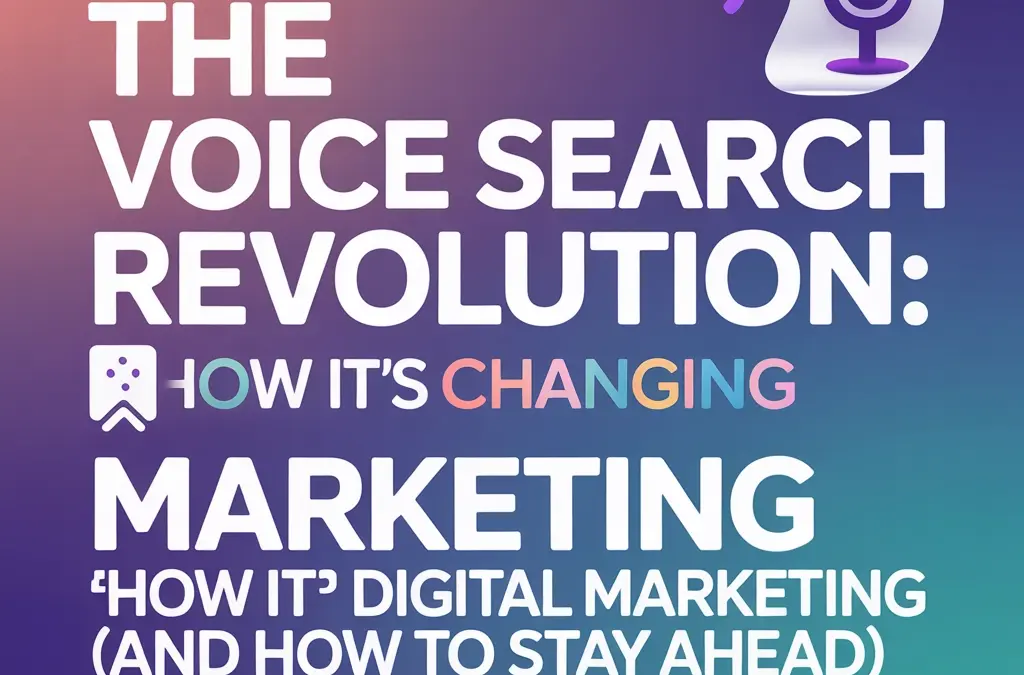Remember when talking to your phone felt weird? Those days are long gone. Voice search has exploded from a novelty feature to a game-changing force that's completely reshaping how people find information online. At Lion Digital Marketing, we're seeing businesses scramble to adapt their strategies as consumers increasingly ditch typing for speaking.
The numbers don't lie – we're witnessing a massive shift in user behavior that's creating both challenges and incredible opportunities for smart marketers.
The Voice Search Explosion: By the Numbers
Let's talk numbers because they're pretty mind-blowing. We're looking at over 1 billion monthly voice searches happening globally right now. That's not a typo – billion with a "B." Even more impressive? About 41% of US adults are using voice search every single day.

This isn't just about convenience anymore. Gen Alpha and Gen Z users are literally growing up speaking to devices before they learn to type efficiently. For them, voice search feels more natural than pecking away at a keyboard. Industry experts predict voice commerce will hit $80 billion by 2025, which means this trend has serious money behind it.
On mobile devices, voice searches now make up 20% of all queries. Think about that the next time you're optimizing content – one in five mobile searches isn't typed, it's spoken.
How Voice Search is Flipping Consumer Behavior
Here's where things get interesting for us marketers. Voice search has fundamentally changed how people look for information. Instead of typing fragmented keywords like "pizza delivery Chicago," users now ask complete questions: "Where can I get pizza delivered near me right now?"
This shift toward conversational search means people are:
- Using longer, more natural phrases
- Asking complete questions instead of keyword fragments
- Expecting immediate, direct answers
- Focusing heavily on local results with "near me" queries
Nearly half of all online searches now happen via voice, with most coming from mobile devices and smart speakers. Users don't want to scroll through ten blue links anymore – they want quick, accurate answers they can act on immediately.
What This Means for Your SEO Strategy
Traditional SEO focused on matching exact keywords. Voice search SEO is all about understanding intent and providing conversational answers. Here's what's changed:
Long-Tail Keywords Are King
Forget optimizing for "Thai restaurant." Now you need to think about "What's the best Thai restaurant that delivers to my area?" These longer, conversational phrases are gold mines because they're exactly how people speak.
Featured Snippets Matter More Than Ever
When someone asks their smart speaker a question, it typically reads back one answer – usually from a featured snippet. If your content can snag that featured snippet spot, you're essentially becoming the voice of authority for that topic.

Local SEO Just Got Even More Important
Remember those "near me" searches? They're absolutely crucial for voice search. More than 55% of consumers use voice search specifically to find local businesses, and over 75% of smart speaker users do local voice searches weekly.
This means your Google My Business profile, local citations, and location-specific content need to be rock-solid.
The Rise of Micro-Moments
Voice search has amplified what Google calls "micro-moments" – those split-second decisions when someone needs to know, go, do, or buy something right now. These brief windows are goldmines for businesses that can provide immediate, helpful answers.
Think about it: someone's cooking dinner and realizes they're out of an ingredient. They don't grab their phone and type – they just ask their smart speaker "Where's the closest grocery store that's open right now?"
Practical Strategies to Stay Ahead
Alright, enough theory. Let's talk about what you can actually do to optimize for voice search today.
1. Write Like People Talk
Start incorporating natural, conversational language into your content. Create FAQ sections that directly answer the questions your customers actually ask. Use phrases like "how to," "what is," "where can I," and "why does."
2. Target Question-Based Keywords
Research the specific questions people ask about your industry. Tools like Answer the Public can show you exactly what questions people are typing (and speaking) about your topic.

3. Optimize for Featured Snippets
Structure your content to directly answer common questions in the first paragraph. Use clear headings, bullet points, and numbered lists. Make it easy for search engines to pull out quotable answers.
4. Double Down on Local SEO
If you're a local business, this is huge. Make sure your Google My Business profile is complete and accurate. Get consistent reviews. Create location-specific content that answers local questions.
5. Speed Up Your Site
Voice search users expect instant answers. If your site takes forever to load, you're out of the running. Focus on mobile page speed especially, since most voice searches happen on mobile devices.
6. Think About Smart Speaker Skills
Consider developing custom skills or actions for platforms like Alexa or Google Assistant. This can help you capture voice search traffic directly and build brand awareness.
The Conversational Content Revolution
Voice search is pushing us toward more natural, helpful content. Instead of keyword-stuffed articles, we need content that genuinely answers questions in a conversational way.
This means:
- Writing in second person ("you" instead of "users")
- Using contractions and casual language
- Anticipating follow-up questions
- Providing complete, actionable answers

Local Businesses: Your Time to Shine
If you're running a local business, voice search might be your secret weapon. People constantly ask questions like:
- "What time does [business] close?"
- "How do I get to [location]?"
- "What's the phone number for [service]?"
- "Is [restaurant] open right now?"
Make sure your business information is accurate everywhere online. Create content that answers these common questions. And definitely claim and optimize your Google My Business listing.
Voice Commerce: The Next Frontier
Voice commerce is exploding. People are using voice commands to reorder products, check on deliveries, and even make new purchases. If you're in e-commerce, start thinking about how customers might interact with your brand through voice.
This could mean optimizing product descriptions for voice search, creating voice-friendly reordering processes, or even developing custom shopping skills for smart speakers.
Measuring Voice Search Success
Traditional analytics don't capture voice search perfectly, but you can track:
- Featured snippet appearances
- Local search ranking improvements
- Increases in direct traffic (people might hear your brand name in a voice response)
- "Near me" keyword performance
- Mobile search traffic growth
The Future is Conversational
Voice search isn't just a trend – it's fundamentally changing how people interact with technology. The brands that succeed will be those that adapt their content and SEO strategies to match how people actually speak and think.

The opportunity is massive, but the window for easy wins is closing fast. Smart speakers are becoming standard household items, voice assistants are getting more sophisticated, and user behavior is shifting quickly.
The question isn't whether voice search will impact your business – it's whether you'll be ready when it does. Start optimizing for conversational queries now, focus on providing direct answers to common questions, and make sure your local SEO game is strong.
Voice search rewards businesses that truly understand their customers and provide genuinely helpful, accessible information. It's time to stop thinking like a search engine and start thinking like the helpful expert your customers need you to be.
The voice search revolution is here. Are you ready to join the conversation?





